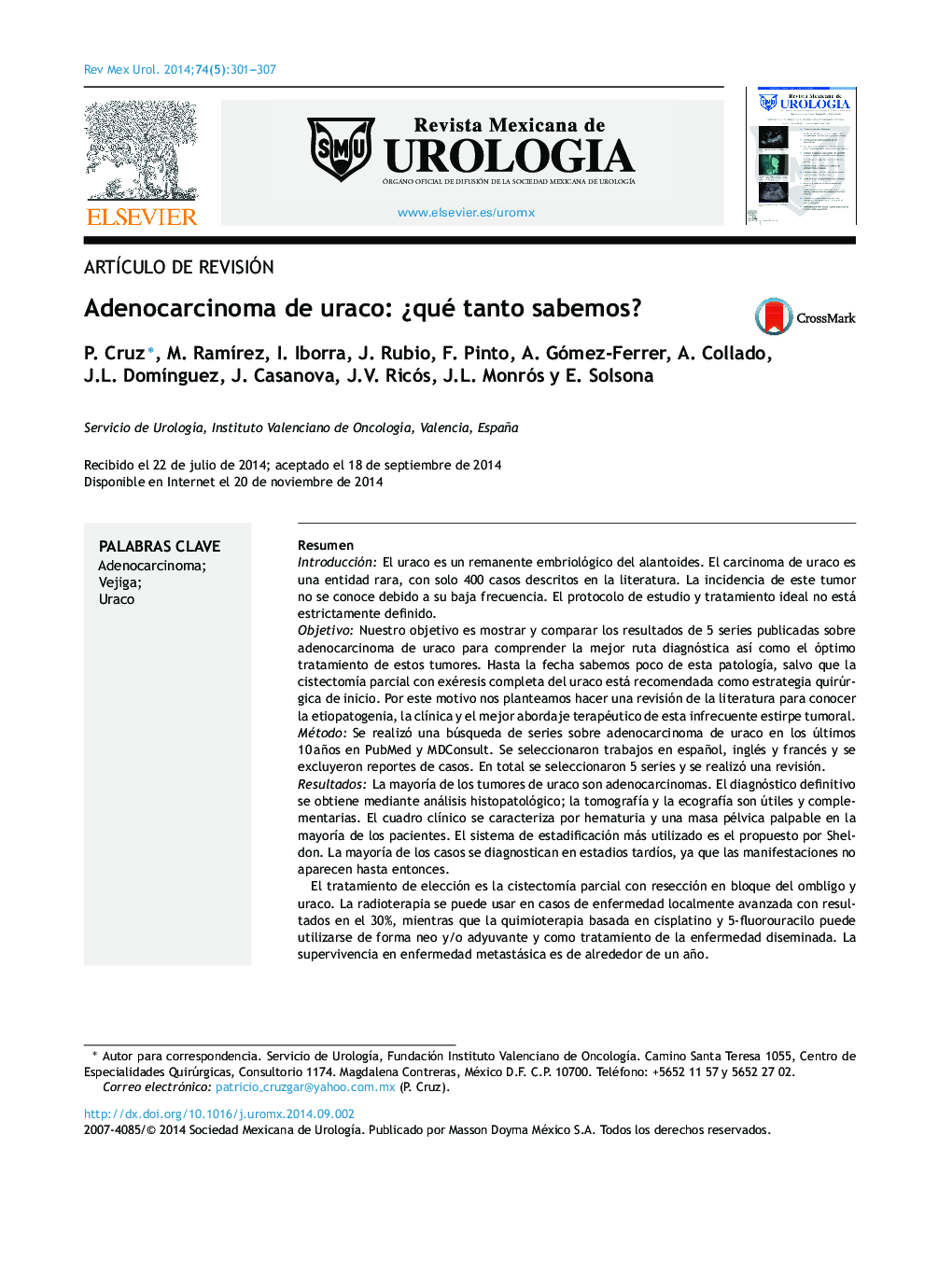| کد مقاله | کد نشریه | سال انتشار | مقاله انگلیسی | نسخه تمام متن |
|---|---|---|---|---|
| 4274379 | 1285259 | 2014 | 7 صفحه PDF | دانلود رایگان |

ResumenIntroducciónEl uraco es un remanente embriológico del alantoides. El carcinoma de uraco es una entidad rara, con solo 400 casos descritos en la literatura. La incidencia de este tumor no se conoce debido a su baja frecuencia. El protocolo de estudio y tratamiento ideal no está estrictamente definido.ObjetivoNuestro objetivo es mostrar y comparar los resultados de 5 series publicadas sobre adenocarcinoma de uraco para comprender la mejor ruta diagnóstica así como el óptimo tratamiento de estos tumores. Hasta la fecha sabemos poco de esta patología, salvo que la cistectomía parcial con exéresis completa del uraco está recomendada como estrategia quirúrgica de inicio. Por este motivo nos planteamos hacer una revisión de la literatura para conocer la etiopatogenia, la clínica y el mejor abordaje terapéutico de esta infrecuente estirpe tumoral.MétodoSe realizó una búsqueda de series sobre adenocarcinoma de uraco en los últimos 10 años en PubMed y MDConsult. Se seleccionaron trabajos en español, inglés y francés y se excluyeron reportes de casos. En total se seleccionaron 5 series y se realizó una revisión.ResultadosLa mayoría de los tumores de uraco son adenocarcinomas. El diagnóstico definitivo se obtiene mediante análisis histopatológico; la tomografía y la ecografía son útiles y complementarias. El cuadro clínico se caracteriza por hematuria y una masa pélvica palpable en la mayoría de los pacientes. El sistema de estadificación más utilizado es el propuesto por Sheldon. La mayoría de los casos se diagnostican en estadios tardíos, ya que las manifestaciones no aparecen hasta entonces.El tratamiento de elección es la cistectomía parcial con resección en bloque del ombligo y uraco. La radioterapia se puede usar en casos de enfermedad localmente avanzada con resultados en el 30%, mientras que la quimioterapia basada en cisplatino y 5-fluorouracilo puede utilizarse de forma neo y/o adyuvante y como tratamiento de la enfermedad diseminada. La supervivencia en enfermedad metastásica es de alrededor de un año.ConclusionesDe ser posible siempre se deberá intentar la exéresis del tumor mediante cistectomía parcial y umbilectomía en bloque, junto con linfadenectomía extendida. Aún no existe un esquema de quimioterapia definitivo, aunque se han buscado diferentes combinaciones.
BackgroundThe urachus is an embryonic remnant of the allantois. Urachal carcinoma is a rare entity, with only 400 cases described in the literature. The incidence of this tumor is not known due to its low frequency, and its study protocol and ideal treatment are not strictly defined.AimsOur aim was to show and compare the results of 5 published series on adenocarcinoma of the urachus in order to understand the best diagnostic course and optimum treatment for these tumors. At present, very little is known of this pathology, except that partial cystectomy with complete exeresis of the urachus is recommended as the initial surgical strategy. We therefore decided to carry out a review of the literature in order to know the etiopathogenesis, clinical manifestations, and best therapeutic approach with respect to this rare tumor.MethodsA search of the PubMed and MDConsult databases covering the last 10 years was carried out for series that have analyzed adenocarcinoma of the urachus. Studies in Spanish, English, and French were selected, excluding case reports. A total of 5 series were selected and reviewed.ResultsThe majority of urachal tumors are adenocarcinomas. The definitive diagnosis is made through histopathologic analysis, with tomography and ultrasound being useful complementary studies. Clinical symptoms are characterized by haematuria and a palpable pelvic mass in the majority of patients. The most widely used staging system is that proposed by Sheldon. The majority of cases are diagnosed in late stages because the manifestations do not appear until then.The treatment of choice is partial cystectomy with en bloc resection of the urachus and umbilicus. Radiotherapy may be used in cases of locally advanced disease, with results in 30% of the patients. Chemotherapy based on cisplatin and 5-fluorouracile can be used as neoadjuvant and/or adjuvant therapy and as treatment for disseminated disease. Survival of the patient with metastatic disease is about one year.ConclusionsWhenever possible, complete exeresis of the tumor should be attempted through partial cystectomy and en bloc resection of the urachus and umbilectomy, together with extended lymph node dissection. Despite the search for different combinations, a definitive chemotherapy regimen has yet to be established.
Journal: Revista Mexicana de Urología - Volume 74, Issue 5, September–October 2014, Pages 301–307